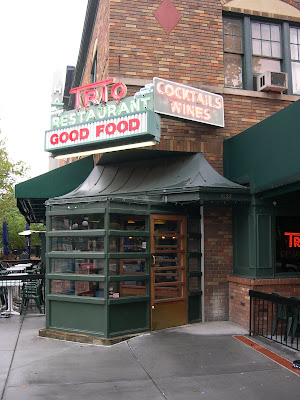Washington Leftovers

On some days during our time in Washington, I would get up early and walk around by myself in the neighborhood around our hotel, which stands at the corner of 15th St. and Rhode Island Ave. I was among other walkers, joggers, bicyclists and dog-walkers and their dogs, and I passed shops, restaurants, the embassies of various nations, foundations, nonprofits, trade associations, churches, gardens and small parks. But more than any of those, restored row houses and mature trees gave the neighborhood its charm.
The still-blooming flowers helped, too, even this riot of past-prime sunflowers.
Just down the street from the hotel on 15th was Grace Reformed Church. While in Washington as vice president and president, Theodore Roosevelt was a member of this church, often walking to Sunday services from the White House, presumably in the company of barely necessary bodyguards, considering TR's big-stick personality. I passed by the church often, but never saw it open.
Neighborhood details, such as the green fire alarm boxes, were easier to access.
A sign on the box said, "Fire alarm boxes such as this one (originally painted red) were installed in the District after the Civil War. Telegraphs transmitted the box number (top) to a fire alarm center. This system was used until the 1970s, when the boxes were converted to a telephone system. By the 1990s, the callbox system had been replaced by the 911 system and was abandoned." As recently as that?
Not all statuary in Washington is of the memorial or monumental variety. This fellow exults across the street from Grace Reformed Church.
Still, some of our area's statuary was quite traditional, down to frequent visits by pigeons, which I saw atop the heads of Daniel Webster and Winfield Scott, both of whom have statues at Scott Circle. Also near the circle is this monument -- a highly aesthetic one, I thought, even if it honors an odd choice: Samuel Hahnemann (1755-1843), father of homeopathy.
I'll give Herr Dr. Hahnemann the benefit of the doubt, since standard medicine in his time was dodgy at best. "Like cures like" was probably as reasonable as most medical ideas of the time. In our time, there's no excuse for homeopathy. There might as well be an aesthetic memorial in Washington to Franz Joseph Gall for developing phrenology.
On one of my walks I discovered Trio, which is at the corner of 17th St. and Q St.
Make that re-discovered, because I'd eaten lunch there on May 8, 1982. There were few other eating options on that particular stretch of 17th at the time. I had veal, served by a waitress with intensely white hair. While not top-notch, the meal had satisfied me as greasy spoons often do.
In 2011, I recognized Trio instantly. The memory rushed back all at once. I hadn't remotely expected the place to still be there after almost 30 years, or even thought about looking for it before I chanced upon it again. The next day we all went there for breakfast, eating al fresco on a flawless summer morning. I had tasty French toast and felt a little of the old satisfaction return. As we were leaving, I spoke to the owner, a gentleman somewhat older than I am. His father, a Greek immigrant, had opened the restaurant in the early 1950s, and it had survived the decline of the neighborhood and later its gentrification -- no mean feat in either case.
"You know, I ate here almost 30 years ago," I told the proprietor.
"You ought to come back more often," he replied.
Early on, I also discovered an upmarket grocery store in our temporary neighborhood, part of a successful national chain. We foraged there a fair amount. One day as I was looking for a small container of milk at this store, standing there in front of a refrigerated case with one of the doors open, a face suddenly appeared in one of the gaps left by removed milk cartons. "You got everything you need, son?" said a man, visibly older than me. I was startled, but said I did. It was a retail experience unlike any other.
We often exited the Metro at Dupont Circle and walked back to the hotel from there. The area around the circle been gentrified. Or, as a native of the Washington area told me, it's "less stabby" than it used to be. But there still seem to be comedians roaming the area.
I like that post, but I don't think I was the first one. Note the building behind the post. It's the embassy of Iraq.
On the whole, the Metro proved reliable for getting around town, though I only speak as a tourist, not a long-time commuter. I'd forgotten the waffle-iron ceilings inside the stations and how often one changes at Metro Center, but it all came back to me. We noticed fairly quickly the high number of down escalators (and a few up ones) that weren't working -- broken due to deferred maintenance or off due to energy costs? Either way, it was annoying.
The voice of the people says so too. This was on a bench at I forget which station.
Dupont Circle's north entrance had the worst of the bum escalators -- 188 feet deep, with the down escalator not working. It's just a down escalator, right? What's the problem? Going down that many steps, especially steel-grooved escalator steps, was mesmerizing, and not in a good way. So we avoided that entrance for boarding the Metro from then on.
While walking around the Tidal Basin, the bottom of one of my shoes came loose. Not completely off -- but enough that I suddenly had a long rubber flap hanging from the bottom of the shoe, making walking a tricky business. Lilly lent me a hair band and I wrapped that around the shoe. It was a temporary fix. Every few hundred feet, the flap would come loose and I would have to re-wrap it. But I managed to see the Jefferson Memorial, the FDR Memorial and the line of cherry trees around the Tidal Basin in that condition. The next day I went to the posh retail nexus at Connecticut Ave. and L St. and found one of the street's non-posh retailers, Filene's Basement, where I scored some new and very comfortable shoes for $38.
Though famed for their brief flowering -- as they should be -- the Tidal Basin cherry trees are also remarkable in summer. The oldest ones are near the new MLK Memorial. Seldom have I seen such gnarled specimens in such profusion, almost blocking the path in places, hogging their patch of the ground tenaciously. It looks like the Park Service long ago planned for the time when these cherry patriarchs, a 1912 gift of the Japanese Empire to the United States, die off. In a lot of places I saw younger cherry trees planted a little further from the edge of the water.
The Reflecting Pool and much else besides between the World War II Memorial and the Lincoln Memorial is currently fenced off for renovation. The sun had already gone down by the time we headed toward the Lincoln Memorial, so the area beyond the those fences was dark and forbidding. But at one point I could see the outline of the District of Columbia World War Memorial off in the distance.
I stumbled across that memorial on a previous visit to Washington. Dedicated to the 499 residents of DC who died in World War I, it was forlorn and in bad shape when I saw it. But maybe someday it will be the national memorial for all the Americans who died in the Great War. The doughboys should have one. Go ahead, sign the petition.
Abner Doubleday is buried not far from Arlington House at Arlington National Cemetery. There's no mention of baseball on his stone, since that story was made up some years after his death. Elsewhere, we saw Audie Murphy. I told Lilly who he was.
As I've said before, pay attention to the famed of a cemetery, but don't ignore the obscure completely. While at the national cemetery, I took a look at some headstones at random. It's good for a moment's reflection, if you're in the right frame of mind. What was this soldier's story? I hope someone knows. He survived the war, but died young anyway.
We spent some time in Washington's Union Station, either buying things or eating things. It's a splendid beaux-arts structure by Daniel Burnham, mostly refashioned in our time to be a mall, though it's also Amtrak's main Washington terminal and connects with the Metro. Much history has passed through.
Because I'd read about them beforehand, I knew about the station's Roman soldiers. "The Main Hall... features a 96-foot high, barrel vault with a decorative, coffered plaster ceiling," notes the station's web site. "Standing around the ledge of the balcony is 36 figures of Roman legionnaires hollow cast in plaster with sand finish. The figures were originally cast as nudes, but railroad officials, fearing the public would be offended, ordered shields be strategically placed on each statue. The shields remain in place today."
Indeed they do.
Speaking of statues, there's a mess of them at the U.S. Capitol. We got in for the last tour of the day on a Saturday, which means we saw the crypt, the rotunda, the old House of Representatives chamber and a few other spots, but not the House or Senate chamber, which are closed on weekends. Getting in at all required a timed ticket, a pass through a metal detector and a bag inspection. Future generations will probably have to submit a DNA sample or undergo a retinal scan. I dimly recall passing through a metal detector and wandering around the U.S. Capitol on my own in 1982, as if it were a state capitol.
Among the National Statuary Hall Collection -- each state gets to place two, except Virginia, which gets an extra one for Washington -- I spied Ronald Reagan, Jack Swigert, Caesar Rodney, Kamehameha I, Dwight Eisenhower, Ephraim McDowell, Huey Long, Hannibal Hamlin, Samuel Adams, Gerald Ford, William Jennings Bryan, Po'pay, John Burke (of North Dakota), James Garfield, Andrew Jackson, Sam Houston, Washington and Jefferson. I looked in vain for Philo T. Farnsworth, since who wouldn't want to see him?
On a whim, I took a picture of Lilly at the foot of the John Burke statue. Now she's probably one of the few teenagers in America to have her photo taken with both Burkes, since I took one of her and Burke at the North Dakota Capitol in 2006. Looking at these pictures side-by-side, I see that they are the same statue.
In the Old House Chamber of the Capitol -- called Statuary Hall these days -- there are small plaques on the floor identifying the location of the desks of House members in the chamber (1807-57) who later became president: J.Q. Adams, Tyler, Polk, Fillmore, Pierce, Buchanan, Lincoln and A. Johnson. I found a few of them and had the satisfaction of standing where Millard Fillmore occasionally sat.
It's likely the only memorial in Washington to the 13th President of the United States. Sign the Compromise of 1850 and send Perry to Japan, and that's all you get. Whatever its other seductions, high office doesn't guarantee immortal fame.
Labels: Washington DC



































